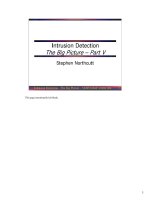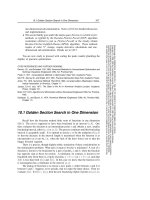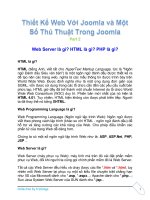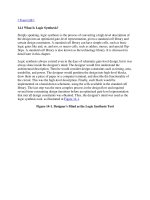Tài liệu Logic Synthesis With Verilog HDL part 2 doc
Bạn đang xem bản rút gọn của tài liệu. Xem và tải ngay bản đầy đủ của tài liệu tại đây (27.62 KB, 8 trang )
[ Team LiB ]
14.3 Verilog HDL Synthesis
For the purpose of logic synthesis, designs are currently written in an HDL at a register
transfer level (RTL). The term RTL is used for an HDL description style that utilizes a
combination of data flow and behavioral constructs. Logic synthesis tools take the
register transfer-level HDL description and convert it to an optimized gate-level netlist.
Verilog and VHDL are the two most popular HDLs used to describe the functionality at
the RTL level. In this chapter, we discuss RTL-based logic synthesis with Verilog HDL.
Behavioral synthesis tools that convert a behavioral description into an RTL description
are slowly evolving, but RTL-based synthesis is currently the most popular design
method. Thus, we will address only RTL-based synthesis in this chapter.
14.3.1 Verilog Constructs
Not all constructs can be used when writing a description for a logic synthesis tool. In
general, any construct that is used to define a cycle-by-cycle RTL description is
acceptable to the logic synthesis tool. A list of constructs that are typically accepted by
logic synthesis tools is given in Table 14-1
. The capabilities of individual logic synthesis
tools may vary. The constructs that are typically acceptable to logic synthesis tools are
also shown.
Table 14-1. Verilog HDL Constructs for Logic Synthesis
Construct
Type
Keyword or Description Notes
ports input, inout, output
parameters parameter
module
definition
module
signals and
variables
wire, reg, tri Vectors are allowed
instantiation module instances,
primitive gate instances
E.g., mymux m1(out, i0, i1, s); E.g., nand
(out, a, b);
functions and
tasks
function, task Timing constructs ignored
procedural always, if, then, else, case,
casex, casez
initial is not supported
procedural
blocks
begin, end, named blocks,
disable
Disabling of named blocks allowed
data flow assign Delay information is ignored
loops for, while, forever, while and forever loops must contain
@(posedge clk) or @(negedge clk)
Remember that we are providing a cycle-by-cycle RTL description of the circuit. Hence,
there are restrictions on the way these constructs are used for the logic synthesis tool. For
example, the while and forever loops must be broken by a @ (posedge clock) or @
(negedge clock) statement to enforce cycle-by-cycle behavior and to prevent
combinational feedback. Another restriction is that logic synthesis ignores all timing
delays specified by #<delay> construct. Therefore, pre- and post-synthesis Verilog
simulation results may not match. The designer must use a description style that
eliminates these mismatches. Also, the initial construct is not supported by logic
synthesis tools. Instead, the designer must use a reset mechanism to initialize the signals
in the circuit.
It is recommended that all signal widths and variable widths be explicitly specified.
Defining unsized variables can result in large, gate-level netlists because synthesis tools
can infer unnecessary logic based on the variable definition.
14.3.2 Verilog Operators
Almost all operators in Verilog are allowed for logic synthesis. Table 14-2
is a list of the
operators allowed. Only operators such as === and !== that are related to x and z are not
allowed, because equality with x and z does not have much meaning in logic synthesis.
While writing expressions, it is recommended that you use parentheses to group logic the
way you want it to appear. If you rely on operator precedence, logic synthesis tools might
produce an undesirable logic structure.
Table 14-2. Verilog HDL Operators for Logic Synthesis
Operator Type Operator Symbol Operation Performed
Arithmetic *
/
+
-
multiply
divide
add
subtract
%
+
-
modulus
unary plus
unary minus
Logical !
&&
||
logical negation
logical and
logical or
Relational >
<
>=
<=
greater than
less than
greater than or equal
less than or equal
Equality ==
!=
equality
inequality
Bit-wise ~
&
|
^
^~ or ~^
bitwise negation
bitwise and
bitwise or
bitwise ex-or
bitwise ex-nor
Reduction &
~&
|
~|
^
^~ or ~^
reduction and
reduction nand
reduction or
reduction nor
reduction ex-or
reduction ex-nor
Shift >>
<<
>>>
<<<
right shift
left shift
arithmetic right shift
arithmetic left shift
Concatenation { } concatenation
Conditional ?: conditional
14.3.3 Interpretation of a Few Verilog Constructs
Having described the basic Verilog constructs, let us try to understand how logic
synthesis tools frequently interpret these constructs and translate them to logic gates.
The assign statement
The assign construct is the most fundamental construct used to describe combinational
logic at an RTL level. Given below is a logic expression that uses the assign statement.
assign out = (a & b) | c;
This will frequently translate to the following gate-level representation:
If a, b, c, and out are 2-bit vectors [1:0], then the above assign statement will frequently
translate to two identical circuits for each bit.
If arithmetic operators are used, each arithmetic operator is implemented in terms of
arithmetic hardware blocks available to the logic synthesis tool. A 1-bit full adder is
implemented below.
assign {c_out, sum} = a + b + c_in;
Assuming that the 1-bit full adder is available internally in the logic synthesis tool, the
above assign statement is often interpreted by logic synthesis tools as follows:
If a multiple-
bit adder is synthesized, the synthesis tool will perform optimization and the
designer might get a result that looks different from the above figure.
If a conditional operator ? is used, a multiplexer circuit is inferred.
assign out = (s) ? i1 : i0;
It frequently translates to the gate-level representation shown in Figure 14-3
.
Figure 14-3. Multiplexer Description









